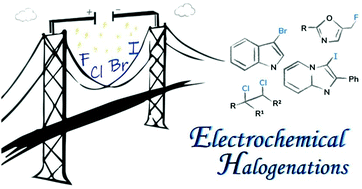Electrohalogenation of organic compounds
Abstract
Herein, we present an overview of recent advances in the electrochemical halogenation of organic compounds. Halogen-containing compounds are essential building blocks for post-functionalization in academic research and in different industrial sectors, notably pharmaceutical companies. One of the main advantages of using electrosynthesis is its environmentally-friendly characteristics. Electrosynthesis is recognized as a methodology that can fulfill different criteria of the green chemistry concept and constitutes a promising tool in the development of new procedures in organic synthesis. In this review we target sp, sp2 and sp3 carbon fluorination, chlorination, bromination and iodination reactions using electrolysis as a redox medium. Mechanistic insights and substrate reactivity are also discussed.

- This article is part of the themed collections: Synthetic electrochemistry and Synthetic methodology in OBC


 Please wait while we load your content...
Please wait while we load your content...